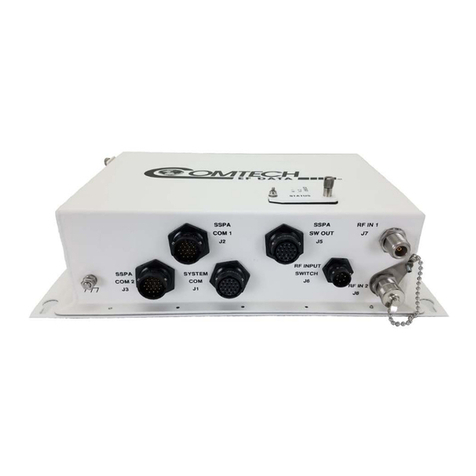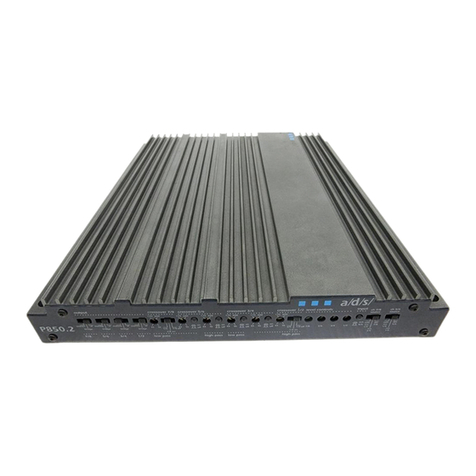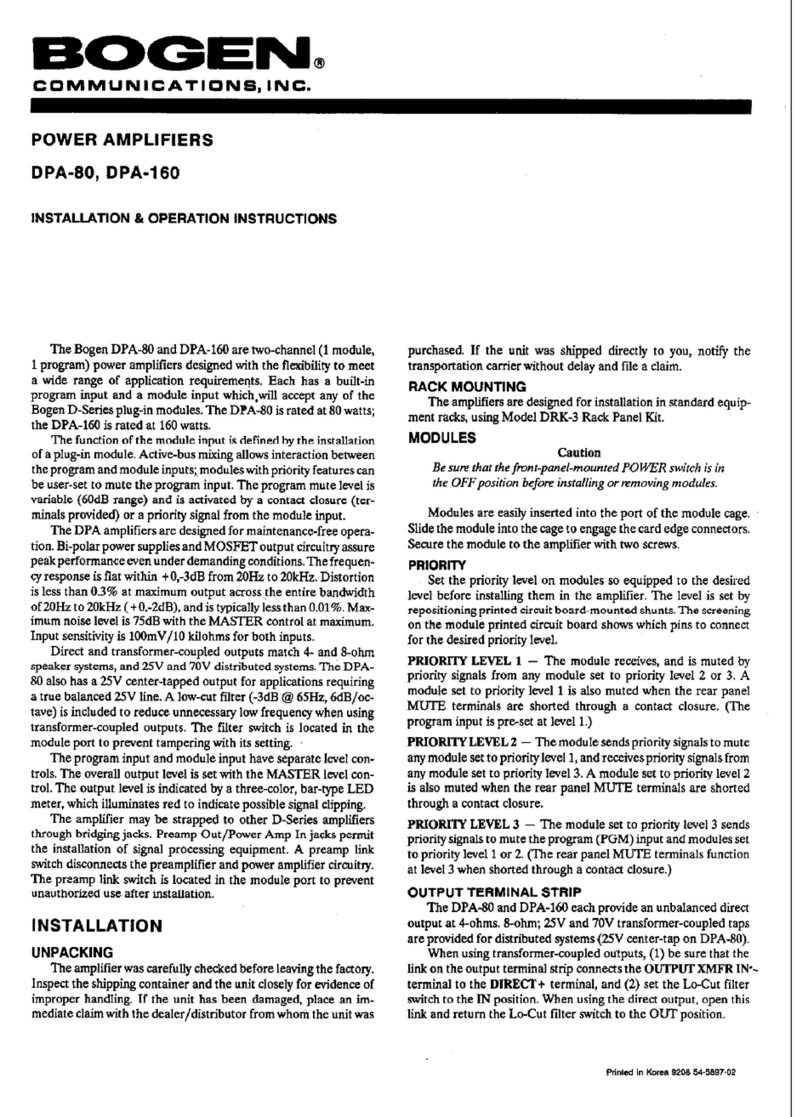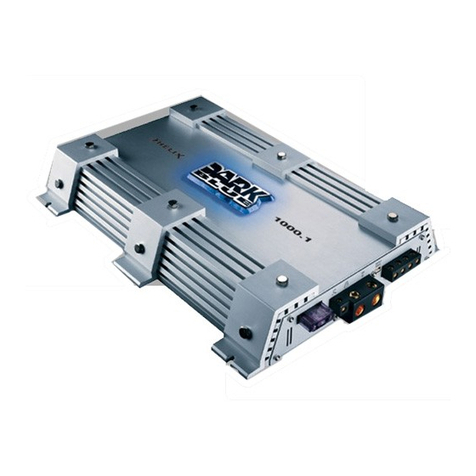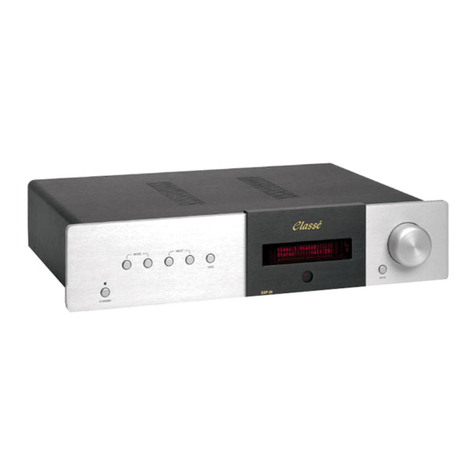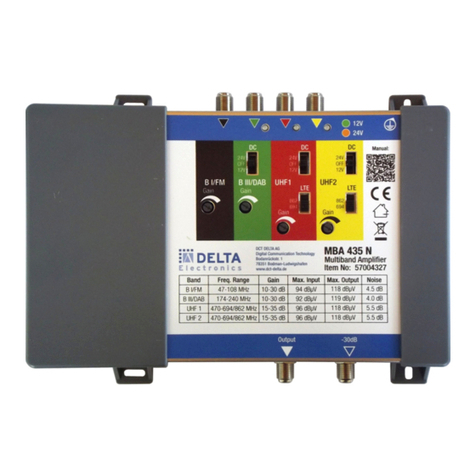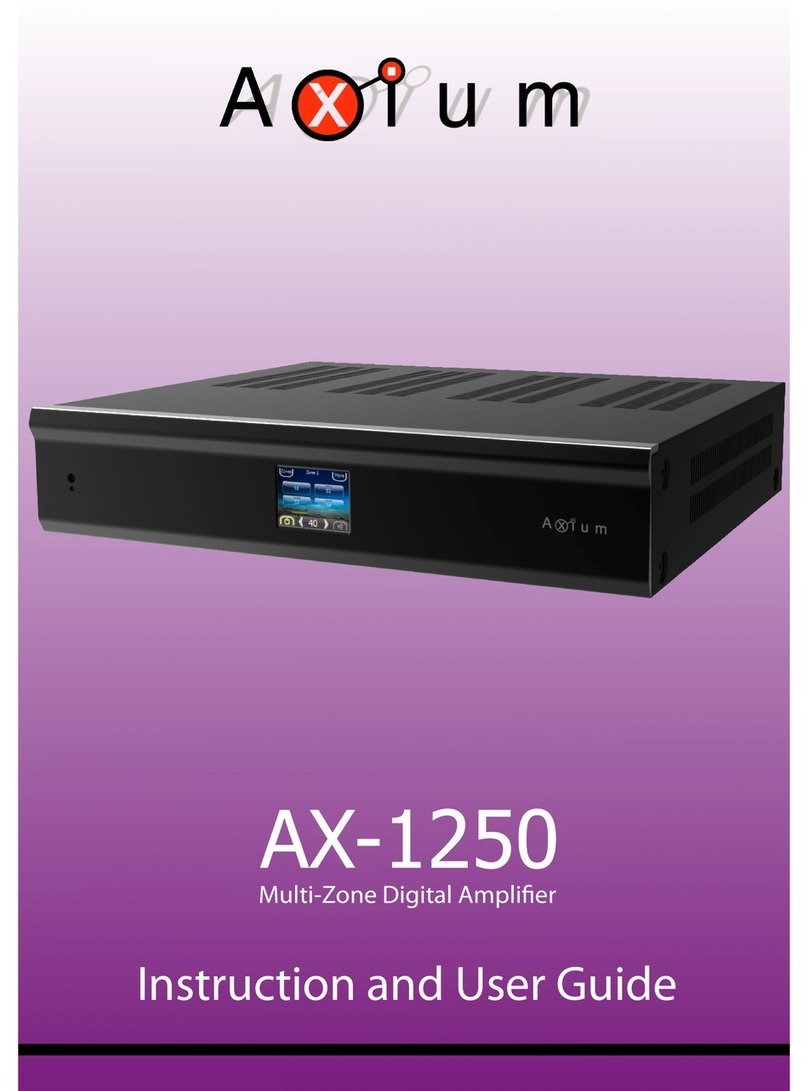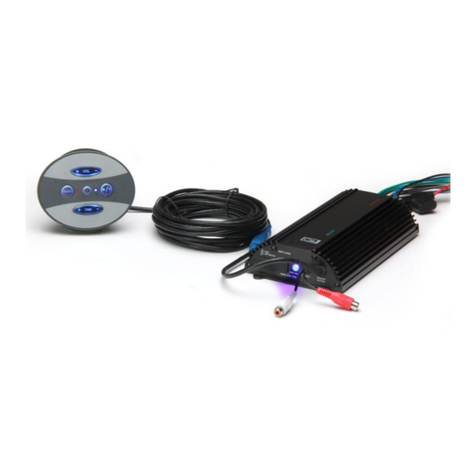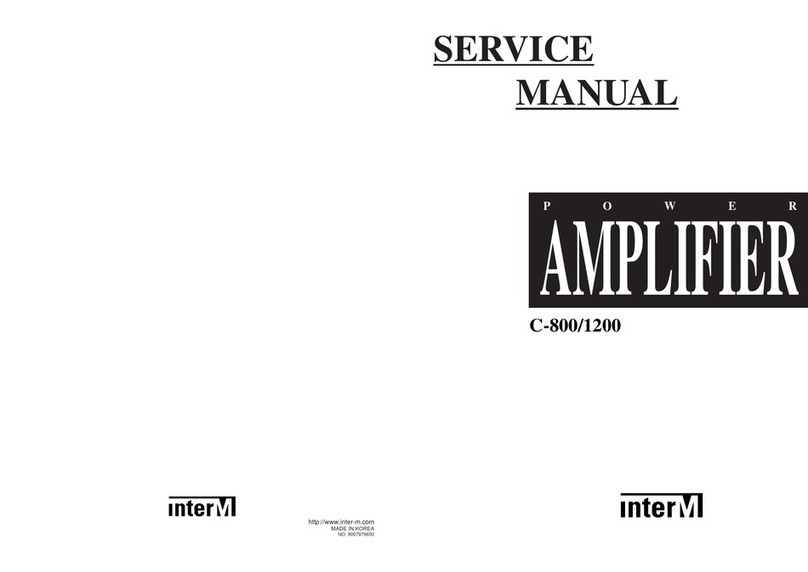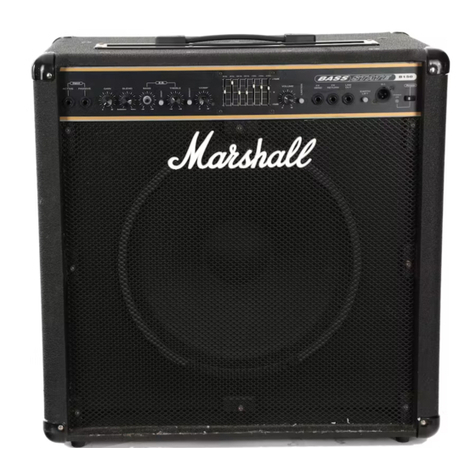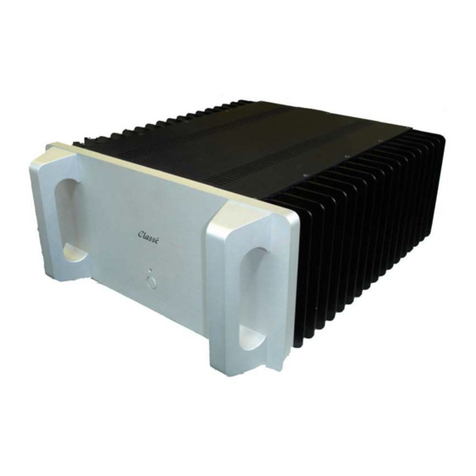THÖRESS SE845 Mono User manual

THÖRESS
845 Single-Ended Triode . Mono . Power Amplifier
======================================
"SE845 Mono"
................................................................
I N S T R U C T I N M A N U A L…..........
Thank you for purchasing the THÖRES SE845 Mono Power Amplifiers!
Our SE845 Mono lock has een tailored around the famous 845 filamentary
power triode in single-ended (class-A) operation mode for an output of 20 watts into
a 4, 8 or 16 ohm load. The amplifier is uilt with meticulous hand construction using
our proven point-to-point wiring techniques. Much care has een taken in arranging
each aspect of the internal construction to ensure low noise performance, ease of
service and the highest relia ility for many years to come. Please read the following
explanations and instructions carefully to get the most out of your SE845 amplifier!
CATHODE POINT BALANCE
The 845 power triode is a filamentary tu e (FT) with a rightly glowing 10V/3.25A
filament which has een developed in the early times of vacuum technology. It
consumes a considera le amount of heating power, 32.5W=10Vx3.25A. The filament
of a FT consists of a thin thoriated tungsten wire mounted with spring suspensions
to mica supports pressed into the glass envelope. The electrons which constitute the
anode (cathode-to-plate) current are emitted y the glowing wire itself (directly) and
not y a cathode pipe insulated from the filament as in case of the more widely used
indirectly heated tu es. The anode current flows through the filament along with
the heater current!
FTs require a specific cathode point implementation outside the vacuum envelope in
order to separate the signal current from the subsidiary heater current!
In the inception of vacuum technology (when semiconductor rectifiers were not in
existence) FTs were AC heated with the aid of dedicated windings on the mains
transformer whereas a M.IDDLE T.AP of the winding served as cathode point (ACMT
cathode point implementation). In our mono lock the 845 tu e is DC heated
whereas the cathode point is given y the junction of a two-resistor (RR) voltage
divider ypassed with a alance potentiometer (BALPOT, mounted on the rear
panel) connected in parallel with the filament. We call this arrangement DCRR

cathode point implementation. The BALPOT allows to alance the cathode point of
the amplifier with respect to the filament of each individual 845 power tu e in order
to ensure equal current flow through oth ends of the tu e filament. Optimal
cathode point alance is attained when the hum induced in the wanted signal via
residual ripple of the heater voltage vanishes (reaches a minimum).
Thoroughly balance the cathode point of the L R amplifier with respect to the filament of
the individual 845 power tube with the BALPOT in the way described in the SETUP
section of this manual!
Check the L R amplifier for optimal cathode point balance from time to time and finely
tune the balance if necessary!
Re-balance the cathode points of the L R amplifier after changing the 845 power tubes!
For a given setting of anode voltage and current, the grid ias voltage Ug(DCRR) of a
given 845 tu e under DCRR cathode point implementation is a out 5V (half the
heater supply voltage, 5V=10V/2) lower than the grid ias voltage Ug(ACMT) of the
same tu e under ACMT cathode point conditions,
Ug(DCRR) <---> Ug(ACMT)-5V.
Nota ly, Ug(DCRR) is the actual voltage etween the 845 control grid terminal and
the DCRR cathode point under alanced conditions in the sense a ove (including the
effects caused y residual grid current). It is important to take this ias shift into
account when making reference to the characteristics of the ideal (average) 845 tu e
as given y the original Amperex or RCA data sheets.
845 OPERATION CONDITIONS
Under ACMT cathode point implementation the ideal (average) 845 tu e draws an
anode current of Ia=0.070A=70mA when it is exposed to an anode voltage of
Ua=950V and a grid- ias voltage of Ug(ACMT)=(-)145V according to the original
AMPEREX data sheets. This represents an excellent operation point for single-ended
operation which we have chosen for the 845 tu e in our amplifier. Corresponding to
a plate dissipation Pa=67W=950Vx0.07A well elow the permissi le design
maximum of 75W,
(Ug(ACMT), Ua, Ia, Pa) = ((-)145V, 950V, 70mA, 67W).
The corresponding quiescent operation point under DCRR cathode point
implementation is
(Ug1(DCRR), Ua, Ia/Pa) = ((-)140V, 950V, 70mA, 67W),
Ug(DCRR)=(-)140V=(-)(145V-5V).
The grid bias voltage for the 845 tube is factory preset to (-)140V and is not meant to get

trimmed by the user in order to adjust the idle current of the power tube!
This design choice makes it especially important to use 845 tu es with
characteristics out of a specific tolerance window. Allowing for a 10% tolerance in
anode current with respect to the ideal 845 tu e, only tu es with an anode current
63mA=70mA-7mA (Pa=60W) … 77mA=70mA 7mA (Pa=73W)
(under the given DCRR voltage conditions (950V, (-)140V)) are suita le for service in
the amplifier. Thus, it is advisa le to use only matched pairs of 845 tu es tested for
the a ove specs supplied y the manufacturer or a relia le tu e supplier.
The use of 845 tubes with inadequate characteristics will lead to inferior sound quality
(idle current too low) or to a reduced lifespan of the 845 tube (idle current too high) due
to overheating!
A carefully selected good quality 845 tube of current production is likely a better choice
than a rare and expensive NOS part with questionable characteristics!
If there is any dou t that a given 845 tu e fulfills the a ove requirements, the actual
idle current Ia can e determined indirectly (with the aid of ohms law) y measuring
the voltage-drop Ud over the winding resistance Rw of the output transformer
primary winding on the living o ject (after the 845 cathode point has een
accurately alanced with respect to the filament), Ia=Ud/Rw.
Measurements within the SE845 amplifier circuitry should be carried out by an
experienced technician only!
TUBE MICROPHONY
Mechanical vi rations of the inner life of a vacuum tu e modulate the anode current
and such are to a small degree converted into noise artifacts which lur the wanted
signal. This effect, called tu e microphony, is particularly pronounced with FTs
ecause the freely suspended filament wire is a le to swing rather easily. Therefor
amplifiers employing FTs need more considerate placement than amplifiers featuring
more commonly used indirectly heated tu es in order to keep the wanted signal free
of microphony artifacts. Tu e microphony is especially critical when highly efficient
loudspeakers are involved, for o vious reasons.
Place the SE845 Mono Amplifier on a rigid rack, shelf or platform carefully decoupled
from the floor in order to keep the signal free of noise artifacts due to tube microphony!
DRIVER TUBES
The SE845 amplifier employs matched pairs of CV2382 (EL822) power pentodes
operated in triode mode (g2 tied to the anode, g3 connected to the cathode) at high
idle current in the driver stage. The amplifier comes with a set of tu es which have

een carefully hand-picked to meet tight specifications. When operated in triode
mode, the ideal (average) CV2382 tu e draws an anode current of Ia=40mA when it
is exposed to an anode voltage of Ua=290V and a control grid ias voltage of
Ug1=(-)8.5V. Allowing for a 10% tolerance in anode current only tu es with
Ia=36mA=40mA-4mA ... Ia=44mA=40mA 4mA
(under the given voltage conditions (Ua, Ug)=(290V, (-)8.5V) are suita le for service
in our SE300B amplifier.
It is strongly advisable to use only carefully tested matched pairs of EL822 driver tubes as
supplied by the manufacturer!
The use of driver tubes with questionable characteristics may lead to inferior sound
quality and, in extreme cases, to damage in the driver circuit!
POWER AMPLIFIER GAIN
The SE845 mono amplifier has een specifically designed to have a moderate voltage
gain (low input sensitivity). This design choice has two enefits. At first, the idle
noise of the line amplifier remains in-audi le even when the amplifier is used to
drive a highly efficient loudspeaker, for example our 2CD12 model (or an even more
efficient horn arrangement). Secondly, the volume control can e operated at a
higher angle of rotation so as to allow for conveniently fine volume adjustment.
Low voltage gain is a desirable feature of power amplifiers, particularly when the
amplifiers are meant to drive highly efficient loudspeakers!
When the SE845 mono amplifiers are used to drive loudspeakers with moderate to
low efficiency it will e necessary to set the volume control (on the line device) to a
somewhat higher than usual angle of rotation to achieve a saturated listening
loudness.
LOUDSPEAKER LOAD MATCHING
The SE845 Mono Amplifier allows for precise 4, 8 or 16 ohm loudspeaker load
matching y way of jumpers soldered to the secondary terminals of the OPT
according to the patterns given elow. Each of which pattern corresponds to a
specific (primary versus secondary) turns ratio of the OPT.
4 ohm loudspeaker
Connect (1 and 2) , (3 and 4) , (5, 6, 7 and 8).
8 ohm loudspeaker
Connect (1, 6 and 8) , (4, 5 and 7).
16 ohm loudspeaker
Connect (1 and 6) , (4 and 7), (5 and 8).

*******************************
1 o o 5
Top Coil
2 o o 6
*******************************
*******************************
3 o o 7
Bottom Coil
4 o o 8
*******************************
o=secondary terminal, 2=speaker RED, 3=speaker BLACK
A single-ended triode amplifier can adequately drive a loudspeaker when the OPT is
configured for a lower load impedance than the rated impedance of the
loudspeaker, especially when the loudspeaker is highly efficient. In this case the
(primary versus secondary) turns ratio of the OPT is higher than the nominal index
value. This reduces the voltage gain ut also the harmonic distortion and the output
resistance of the amplifier, at the expense of a somewhat lower maximal power
output.
It can be beneficial to use a 16-ohm loudspeaker with the 8-ohm or even the 4-ohm load
pattern of the OPT, especially when the speaker is highly efficient!
It is possible to use a 8-ohm loudspeaker with the 4-ohm load pattern of the OPT,
especially when the speaker is highly efficient!
On the other hand, a compromised amplifier performance is definitely to e
expected when the OPT is configured for a higher load impedance than the rated
loudspeaker impedance. Thus:
It is not advisable to use a 4-ohm rated speaker on the 8-ohm or 16-ohm load pattern of
the OPT!
It is not advisable to use a 8-ohm rated speaker on the 16-ohm load pattern
of the OPT!
FUSE
The SE845 mono amplifier draws a current of a out 0.7/1.4A from the
230Vac/115Vac mains corresponding to a power consumption of 160W. It is
protected with a
2A slow-blowing 5x25mm fuse
inside the power inlet module. Occasionally, the fuse may low at the moment of

switching-on (due to the current spike drawn y the mains transformer in this
instant). In case this condition arises more regularly it is advisa le to use a fuse with
a somewhat higher current rating.
SETUP
To set up a pair of SE845 Mono Amplifiers power off all devices of the setup and
proceed as follows.
Do not connect the amplifiers to the mains until steps 1 to 5 have een taken!
Do not connect the amplifiers to the preamplifier until steps 1 to 8 have een taken!
1. Make sure that the power switch on the power inlet module is in OFF position on
oth mono locks.
2. Bring the BALPOT into middle position on oth units.
3. Install the tu es carefully.
Never switch on the amplifier until ALL tubes have been installed!
Never pull out a tube of the socket while the amplifier is powered on!
Filamentary tubes (FT) such as the 845 are fragile devices and must be handled with
exceptional care!
Never move or even transport a 845 power tube as long as it is still hot!
Always de-install all tubes and wrap them in their original protection case before
shipping or transporting the amplifier!
4. Bring the amplifiers into their final position. Here y take into account the notes
made in the section TUBE MICROPHONY.
5. Connect the L+R amplifier to the L+R loudspeaker. Ascertain that the load
matching installed on the output transformer suits the loudspeaker impedance. Take
notice of the explanations presented in this regard in the section LOUDSPEAKER
LOAD MATCHING of this manual.
6. Connect the L+R amplifier to the mains .
7. Balance the cathode point of the L-monoblock with respect to the filament of
the installed 845 tube in the way described below.
Power on the L-amplifier with open input (no ca le connection) while the R-
amplifier remains switched off. Wait for a out one minute until the warm-up
process on the amplifier has come to an end. O serve the residual hum radiated y
the L-loudspeaker and adjust the BALPOT of the L-amplifier (see paragraph CATHODE
POINT BALANCE) until the hum noise vanishes (reaches a minimum). Here y it is
important to o serve the noise at a out 0.5m distance to the woofer(s) rather than
at the listening position, with regard to room modes (specific areas in the auditory
where the sound power distri ution peaks or dips thanks to standing waves
etween pairs of (sound reflective) room oundaries, particularly opposite walls).
Power off the L-amplifier after the cathode alancing procedure has een

accomplished.
8. Balance the cathode point of the R-channel monoblock with respect to the
filament of the installed 845 tube in a similar manner. Power off the R-amplifier
after the balancing procedure has been completed.
Check the amplifiers for correct cathode point balance from time to time and finely tune
the balance if necessary!
Always re-balance the L R amplifier after changing the 845 power tube!
9. Connect the L+R amplifier to the preamplifier.
10. Make sure that the volume control kno rests in zero position.
11. Power on the preamplifier and the program source(s) while the R+L power
amplifier is powered off. Wait until the warm-up process on these components has
come to an end.
12. Complete the setup y powering on the L+R power amplifier.
Always power on the program sources and the preamplifier first and then switch on the
SE845 power amplifiers, observing a delay of at least 30 seconds!
When powering off the system, always switch off the power amplifiers first, then switch
off the other components of the system, observing a delay of at least 30 seconds!
Keep the original crates and tube protection cases for later use. They have been
specifically designed for safe transport under rough conditions!
F E A T U R E V E R V I E W
•All-Tu e Mono Power Amplifier utilizing the famous filamentary 845 power
triode in single-ended (class-A) operation mode.
•20 watts of output power.
•Minimalist (pure class-A) zero-feed ack schematic.
•Powerful single-stage driver utilizing two CV2382 (EL822) power pentodes
operated in triode mode at high idle current.
•High grade electrolytic capacitors (made in Germany) in the power supply.
•C-core filter choke made in-house.
•Ultimate tape wound cut core (C-core) output transformer with dual-coil winding
manufactured in-house.
•Precise 4, 8 and 16 ohm loudspeaker load matching y soldering jumpers setting
to the secondary terminals of the output transformer.
•Low noise low leakage mains transformer produced in-house for 230Vac (115Vac
via jumper setting), 100Vac (Japan), 120Vac (USA, Canada), 220Vac (South Korea,
China, Thailand, Indonesia), 240Vac (UK) or 245 Vac (Australia).
•Full hand construction, point-to-point wiring throughout.
•Non-magnetic case (aluminium throughout), anodized printing on front and rear
panel, powder-coated chassis and lids.

•Dimensions: 150x595xH330 mm,
330=20/feet+210+150/tu e over case,
595=575+20/speaker terminals, weight 18 Kg (each mono lock).
•Dimensions of the shipping crate: 950x400xH460 mm.
................................................................
THÖRESS...
A Tribute to Professional Audio Components
from the Golden Age of the Electronic Tube !
................................................................
Table of contents
Other THÖRESS Amplifier manuals
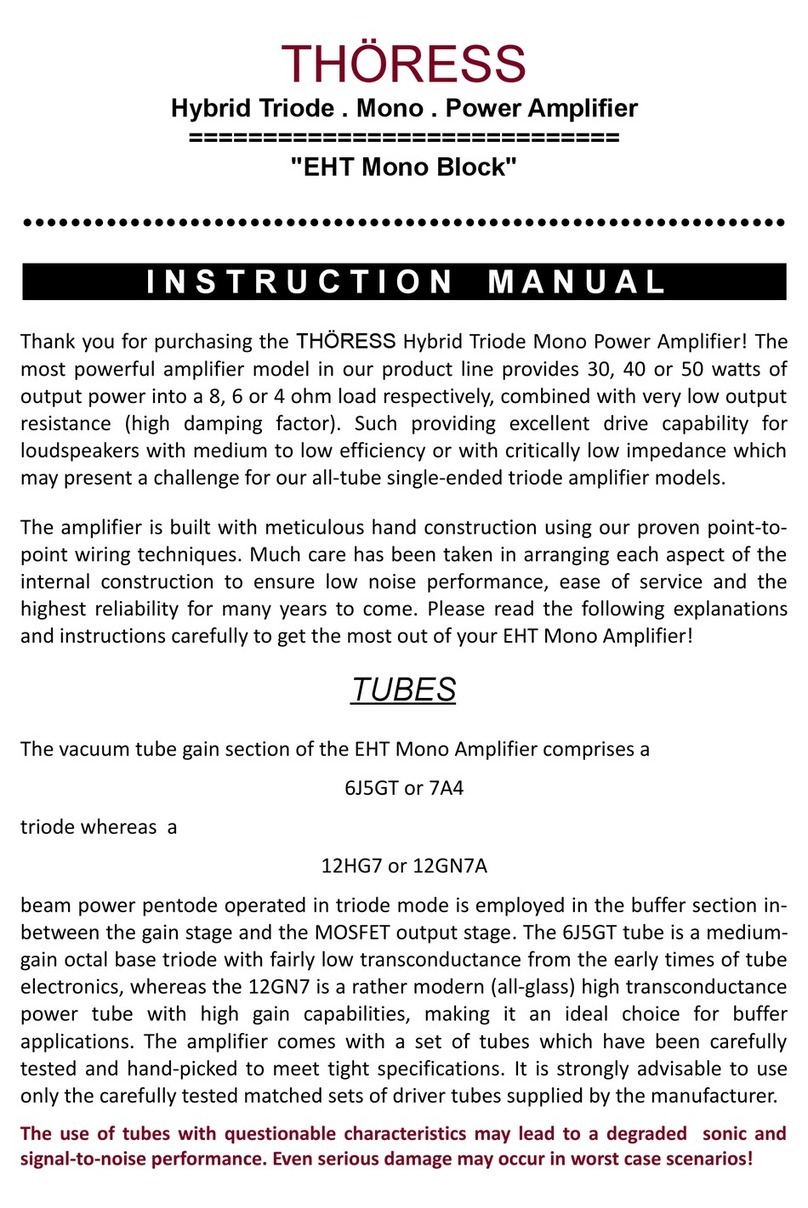
THÖRESS
THÖRESS EHT Mono Block User manual

THÖRESS
THÖRESS Parametric Phono Equalizer Series User manual
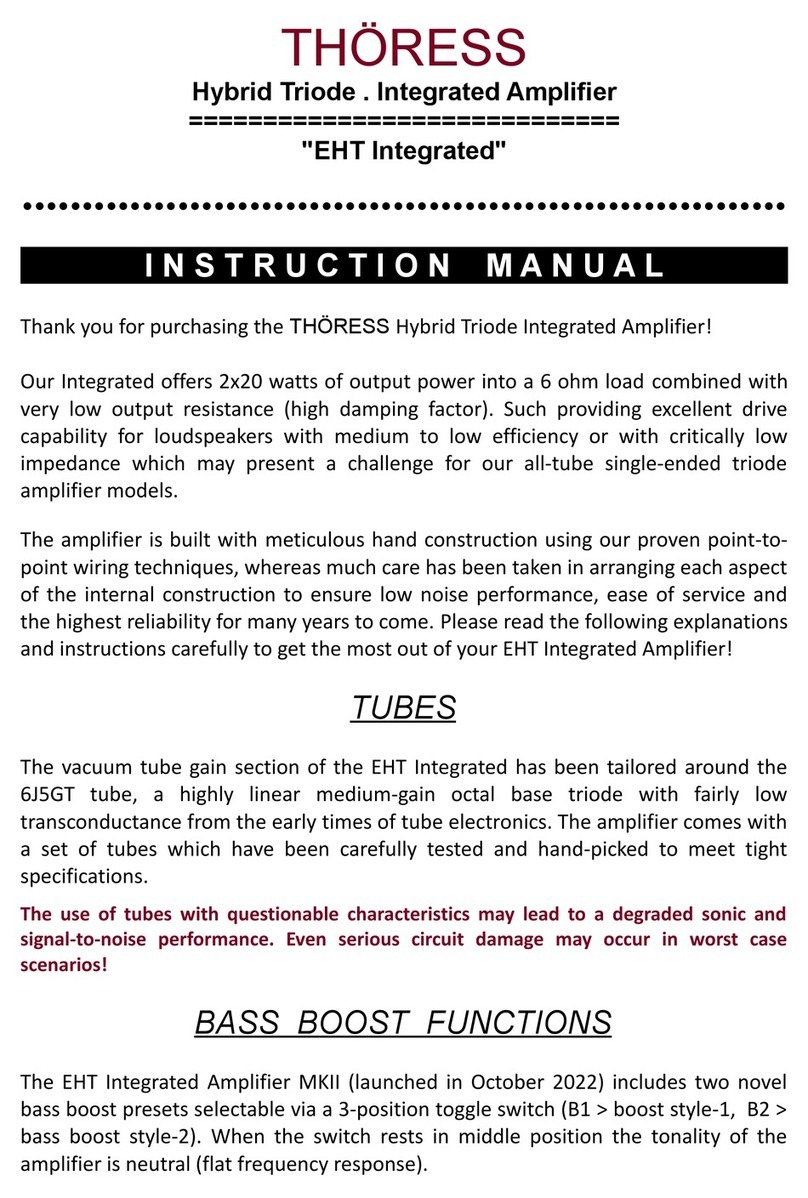
THÖRESS
THÖRESS EHT Integrated Amplifier MKII User manual
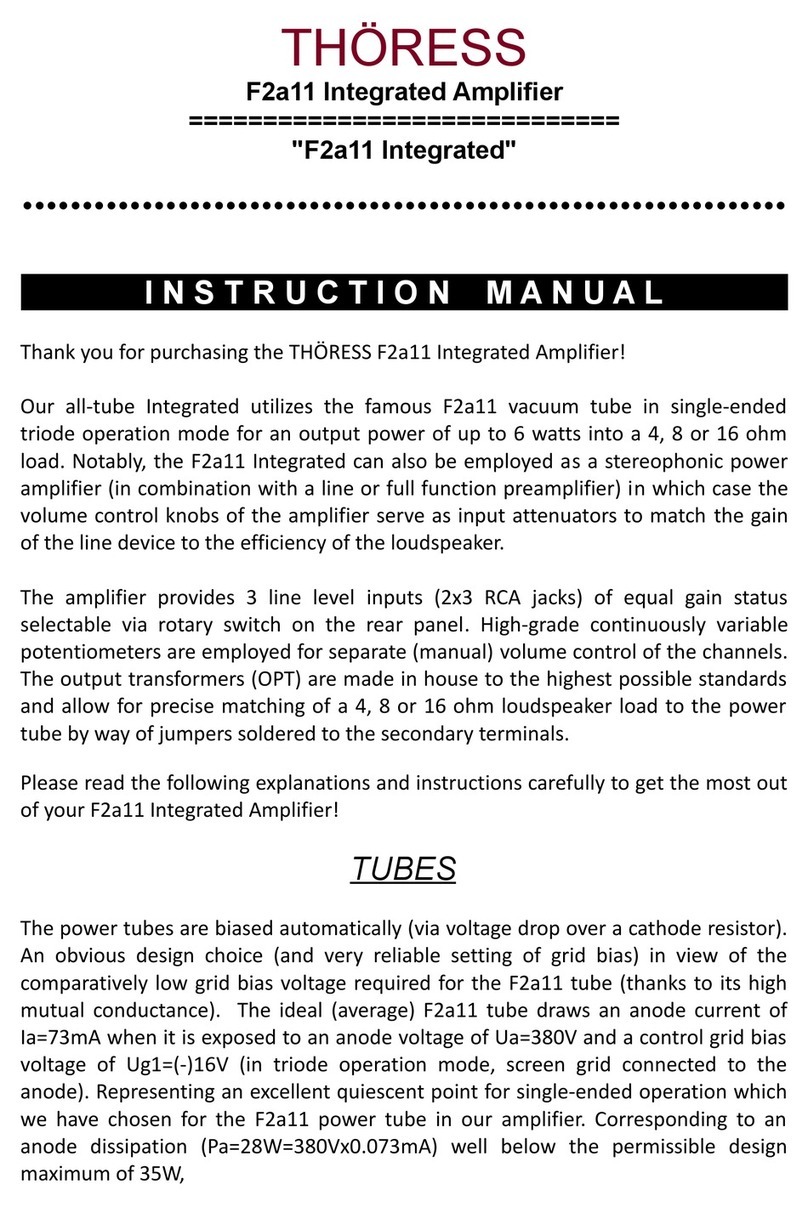
THÖRESS
THÖRESS F2a11 User manual

THÖRESS
THÖRESS 300B User manual

THÖRESS
THÖRESS SE300B User manual
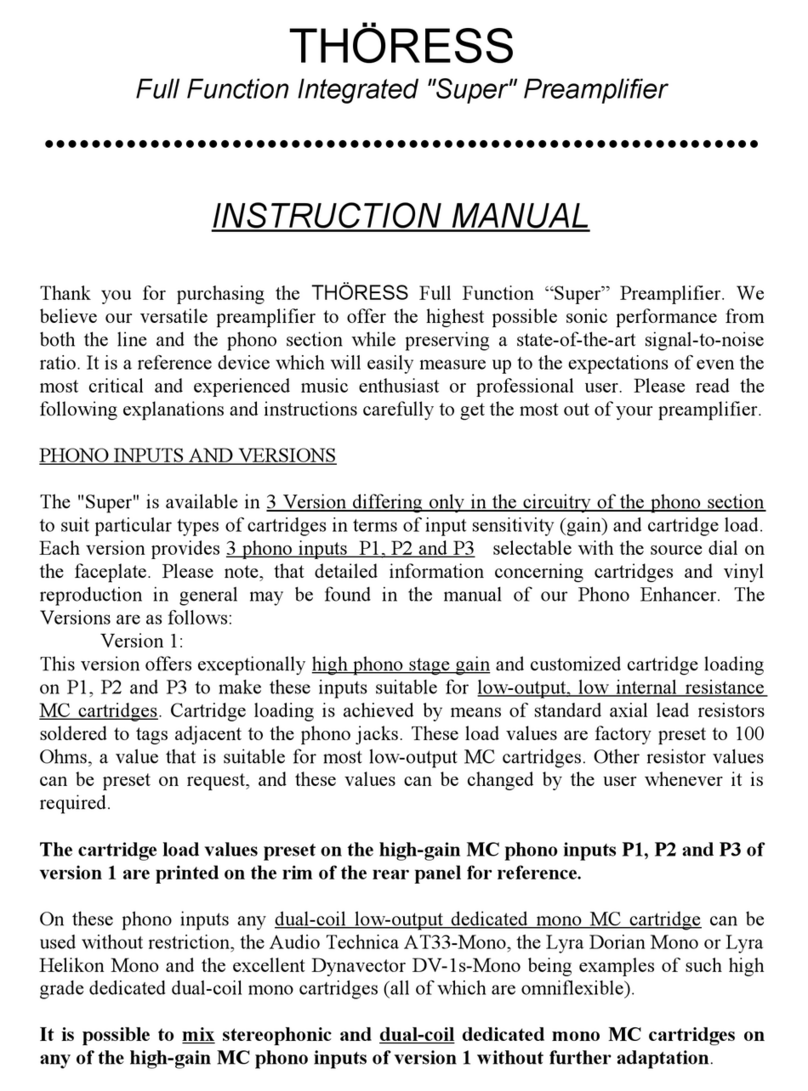
THÖRESS
THÖRESS Full Function Integrated "Super"... User manual
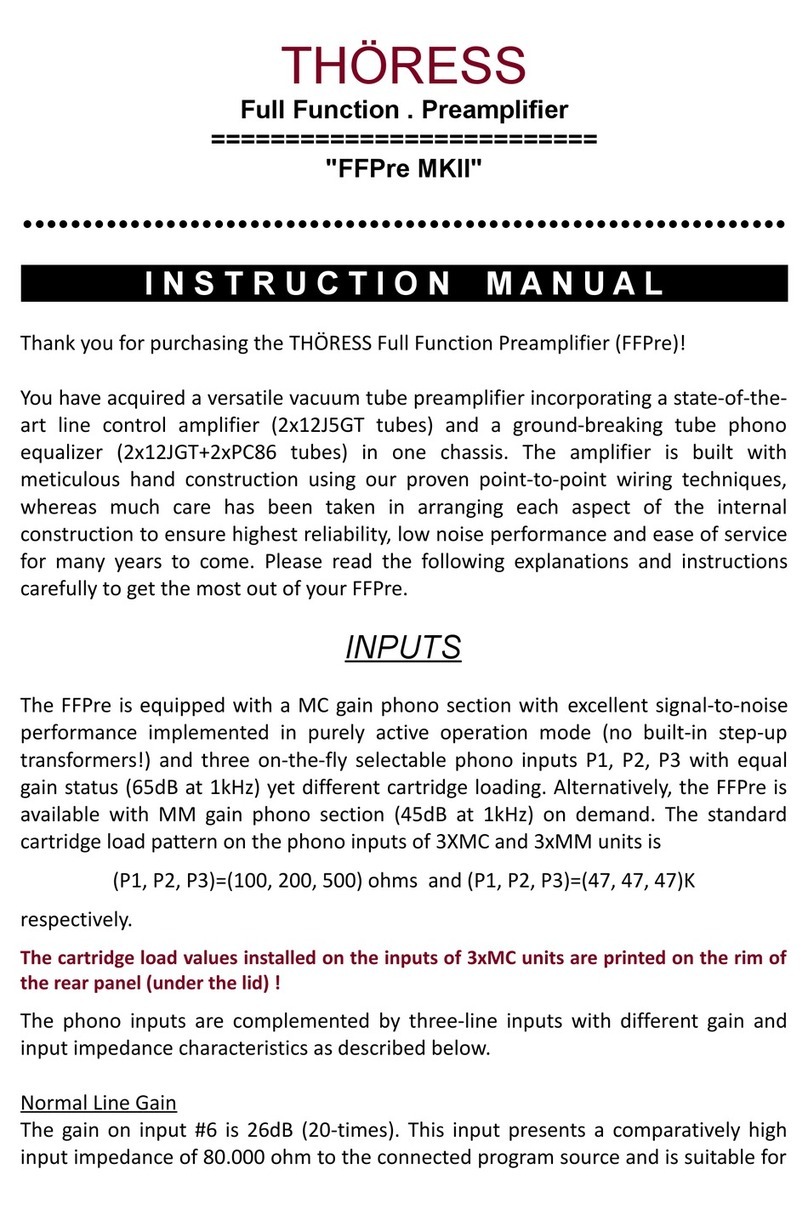
THÖRESS
THÖRESS FFPre MKII User manual
